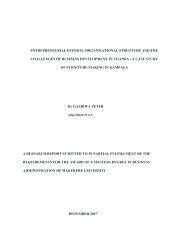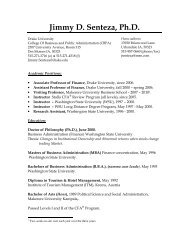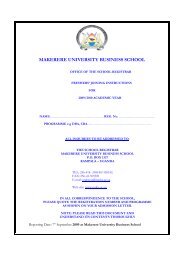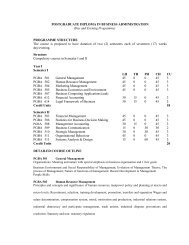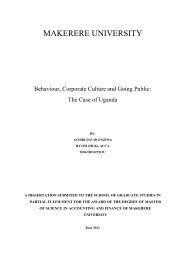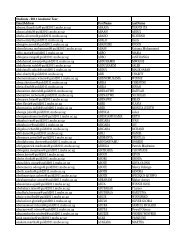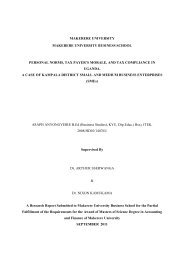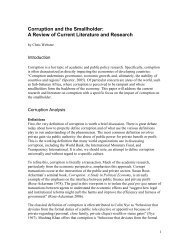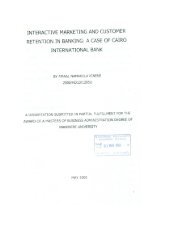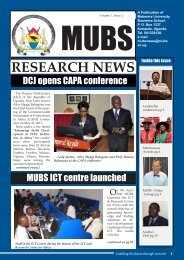13th Annual International Management Conference Proceeding
13th Annual International Management Conference Proceeding
13th Annual International Management Conference Proceeding
You also want an ePaper? Increase the reach of your titles
YUMPU automatically turns print PDFs into web optimized ePapers that Google loves.
its own. Relationship-based assets can exist at various levels: with customers, with partners, and with suppliers. However,<br />
Penrose (1959) recognized over four decades ago that it is not the firm’s resources but the services that those resources<br />
render that are of value to the firm.<br />
Nowadays the dominant view of business strategy –resource-based view of firms – is based on the concept of economic<br />
rent and the view of the company as a collection of capabilities. This view of strategy has a coherence and integrative role<br />
that places it well ahead of other mechanisms of strategic decision-making (Kay, 2003). The resource-based perspective<br />
highlights the need for a fit between the external market context in which a company operates and its internal<br />
capabilities. It is grounded in the perspective that a firm's internal environment, in terms of its resources and capabilities,<br />
is more critical to the determination of strategic action than is the external environment. Instead of focusing on the<br />
accumulation of resources necessary to implement the strategy dictated by conditions and constraints in the external<br />
environment (input/output model), the resource-based view suggests that a firm's unique resources and capabilities<br />
provide the basis for a strategy. The strategy chosen should allow the firm to best exploit its core competencies relative<br />
to opportunities in the external environment (Hitt, Ireland, & Hoskisson, 2001).<br />
The drawback with resource-dependency theory is that it does not fully explain corporate (firm) performance. We<br />
contend that the resource-based view is not firmly established, its application is perceptive and its Concepts are<br />
unsettled. First, there are certain assumptions; that resources are diversely distributed across competing firms and<br />
resources are imperfectly mobile with the four attributes: value (productivity) resource, rareness, imperfect imitability,<br />
and nonsubstitutability (Barney, 1991). In addition, Peteraf (1993) presents four conditions in which resourcedependency<br />
theory can generate superior firm performance: superior resources (heterogeneity within an industry), ex<br />
post limits to competition, imperfect resource mobility, and ex ante limits to competition, all of which must be met in<br />
order to generate superior performance. The resource-dependency theory cannot always allow firms to generate superior<br />
performance based on the existing assumptions and conditions due to the dynamic characteristics of the current market<br />
environment in which consumers taste, preferences, and behaviors are always changing together with the offerings of<br />
suppliers’ resources (Dickson, 1996). Human resources, for example, cannot be taken to be immobile in this respect.<br />
Even then, other critics (Drejer, 2000; Wade & Hulland, 2004) have posited that the assumption of perfect imitability<br />
promotes ambiguity leading to a conclusion that firms are static which overlooks their desire to develop an arsenal of<br />
intellectual capital resources overtime. This perfect imitability assumption is difficult to sustain in this era of<br />
information technology where firms are always in search of intellectual capital resources to sustain superior<br />
performance.<br />
Institutional theory<br />
The past two decades have seen a major reassertion of institutional theories in social sciences and beyond (Guy, 2000).<br />
The March and Olsen (1984) article in the APSR cited by Guy, 2000 was the beginning of the insurrection against the<br />
methodological uniqueness of both behaviorism and rational choice approaches. Although a proliferation and<br />
application of institutional theories can be traced back from March and Olsen (1989; 1994; Brunsson and Olsen, 1993;<br />
Olsen and Peters, 1996), Sociologists like DiMaggio and Powell, 1991; and Scott, 1995; Zucker, 1987 have resurrected<br />
institutional approaches to the basic questions in this discipline. While this proliferation is gratifying to those who never<br />
give up on this theory, we argue that this theory ignores voluntary disclosure of information and therefore the signaling<br />
effect of such information. In fact, Stigler (1964a, 1664b) and subsequently Benston (1982a, 1982b) question the<br />
necessity and efficacy of continuous disclosure as advocated by shareholders. Developing the socio-cognitive perspective<br />
in their study, Carpenter and Westphal (2001) note that individuals cope with complex decision- making tasks by<br />
relying on the knowledge structures they have developed about their environment and from experience in similar roles.<br />
Accordingly, they argue, directors are likely to use knowledge structures developed from their experience on other boards<br />
and to learn about business practices through their social interaction and communication with other directors in board<br />
and committee meetings, as board members evaluate management and raise ideas and suggestions for better strategy<br />
implementation. Information acquired from fellow directors may be particularly influential because it often comes from<br />
a trusted source and is typically more timely and current than that derived from secondary sources. While the focus of<br />
Dimaggio & Powell (1991) is the homogenization that emerges out of institutional isomorphism, this observation does<br />
not blend well with institutional theorists. This is because these social connections and opportunities for vicarious<br />
learning can lead to more highly developed knowledge structures for implementing strategy. Recent academicians<br />
notably Williams (2001) have concluded that to maintain any superior performance it has, a firm could reduce the<br />
intellectual capital disclosure levels in an effort not to signal competitors and others as to where potential opportunities<br />
may lie.<br />
3



